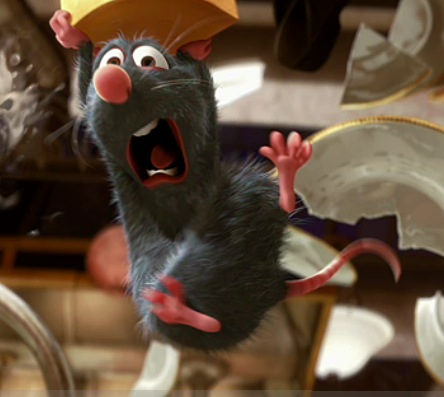On Sex(ism) and Ratatouille
Wow, busy times around these parts this weekend. In no thanks to me. But I had a busy weekend of movie-watching, sun-enjoying relaxation. Part of this included going to see Ratatouille yesterday at a matinee showing (read: most of the audience had a single-digit bedtime and a single-digit age). As critic after critic has pronounced, the film is pretty fantastic. The animation is incredible, the humor better for adults than for kids.
There’s a minor but not major spoiler alert here…..
OK, so being the always-(hyper)alert feminist that I am, I was particularly struck by a scene in which Colette, a female assistant chef in the kithen of Gusteau’s, the restaurant where the action takes place, gives the protagonist (Linguini) a stiff talking to. She angrily tells him that she is the toughest cook in the kitchen. Her monologue comes complete with knife trick to prove her toughness. She’s had to be tough, she says, because haute cuisine is and has long been patriarchal and very very male. There’s no doubt that Colette is right. Fancy kitchens have long been the realm of men, in stark contrast to the kitchens of the home, (too) long thought to be the domain of women. And while I cheered internally at her “I am woman breaking down walls, hear me roar” approach, I couldn’t help but be a little disappointed at her tacit acceptance of the strcuture even as she tried to find a place within it.
As Margot Magawan wrote in a recent WIMN’s Voices post on the film:
In “Ratatouille,” the movie acknowledges this imbalance when Colette, a female human sous chef, gives a speech about how hard it was to succeed in male dominated kitchens. But this brief monolgue is simply an acceptance of sexism instead of a challenge to it.
When I complained to my mom and sister: “Why couldn’t Ratatouille have been female? Why no girls – again?” They said, “Didn’t you hear Colette’s talk? That’s how it is in the real world.” OK, let me get this straight: It’s just fine to stretch our imaginations to believe in a talking rat who can cook, but when it comes to gender roles, we
admire realism and authenticity?
Sure, sure, I know what you’re thinking. It’s a cartoon. Get over it. But that’s the thing. It’s a cartoon. Which means it’s got a huge audience of kids (even though the hardest laughs — by far — came from adults at yesterday’s showing). And time and again, these kids are presented with an image of boys as leads, adventurers, magicians, even cooks, while girls are the princesses in need of rescue (even Colette, here, turns out to be a tough girl with a soft feminine center) or sidekicks. And the roles seem to be continuing into adulthood.
So while I was bowled over by much of Ratatouille (not least of which the precision and beauty with which they recreated a fancy french kitchen), when it came to gender representation, I couldn’t help but smell a rat.
Bad pun intended.



